Are you contemplating buying a rocking horse for your child because you are a first-time parent and have heard that rocking horses were children’s all-time favorite toy?
rocking horse
Or are you reading this because you own an antique rocking horse and would like to sell it to a new parent or a collector? You might ask, “How old is my rocking horse?” “Is my old rocking horse in acceptable condition for sale?” or “What is the value of an antique rocking horse?”
Then you are in the right place. This article contains all the information you need to know about identifying the best rocking horse and determining the age and value of your antique rocking horse. Continue reading to find out.
Table of Contents
The History of Antique Rocking Horses
Rocking horses originated in medieval times as a popular children’s toy known as the hobby horse. It is a toy with a fake horse head attached to a long stick that children can ride on for fun like an actual horse.
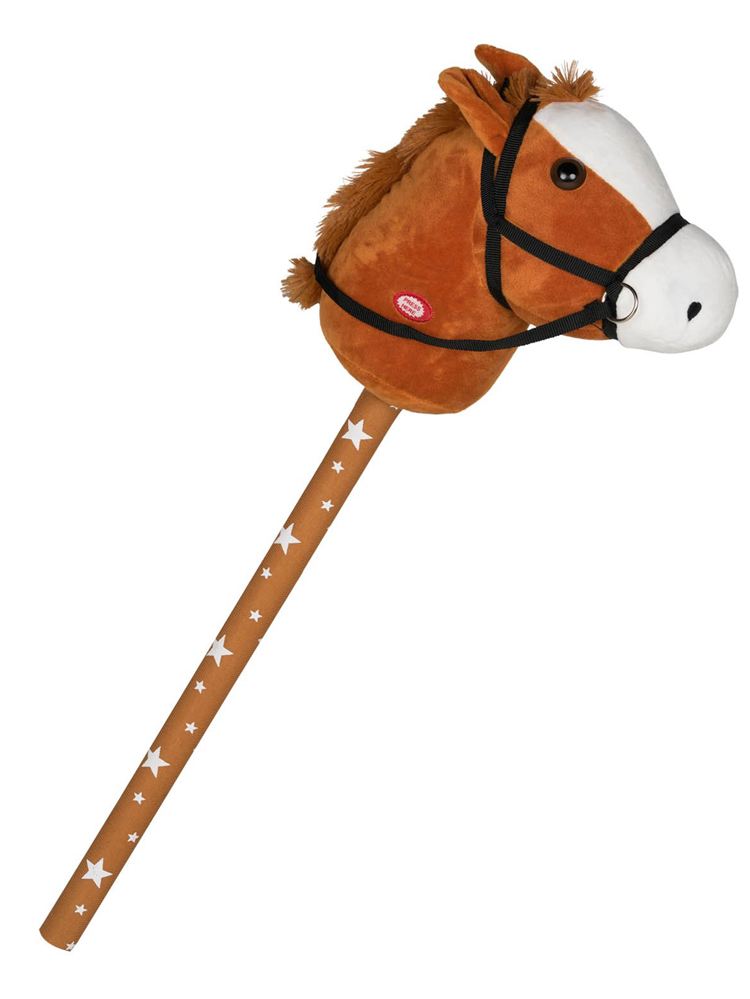
The hobby horse was replaced in the 16th century by the barrel horse, a round piece of wood supported by four legs and adorned with a faux horse head. Despite its crude appearance, this toy resembled a horse’s back better than a hobby horse.
It is generally believed that the rocking horse in its current form first appeared in the early 17th century, around the same time as the production of bow rockers, introducing rocking to the world of toy horses.
However, modifications were required for the initial rocking horses. They were prone to toppling over due to their solid wood construction and high center of gravity.
During the Victorian era, both the “safety stand” and the idea of hollowing out horses were developed. This made the horses lighter and more stable, and it inspired the idea of installing a secret compartment in the horse’s abdomen.
The family heirloom horse may contain photographs, or even money for future generations to discover!
The most popular design during this time period was the dappled gray rocking horse, which was a favorite of Queen Victoria. Her love of rocking horses was a big part of why they became so popular.
Different Styles of Antique Rocking Horses
Since the transition from hobby horses with sticks and plastic horses to rocking horses, manufacturers have developed two distinct types of rocking horses.
The first has a bow-like base that allows for back and forth movement, while the second has a firmer base. In the following section, we will look at the two main types of antique rocking horses.
Bow Rockers
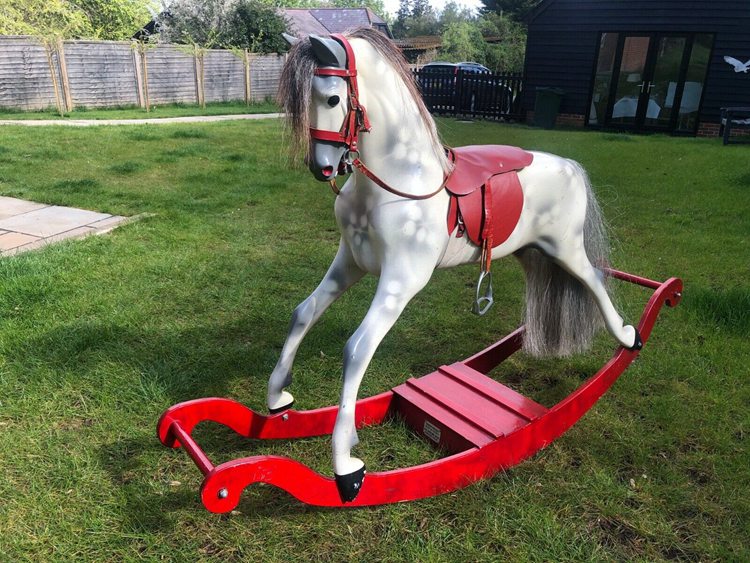
Bow Rockers were introduced in the 17th century, and as their name implies, they are rocking horses with four limbs extending from a bow-shaped base. This bow-shaped base is similar to that of a bow and arrow.
The bow-shaped base of the horse rocker allows it to rock back and forth, making it a more entertaining toy for children. On Etsy, a Bow Rocker antique rocking horse’s value is $2,810.
Marqua Swing Stand Rocker
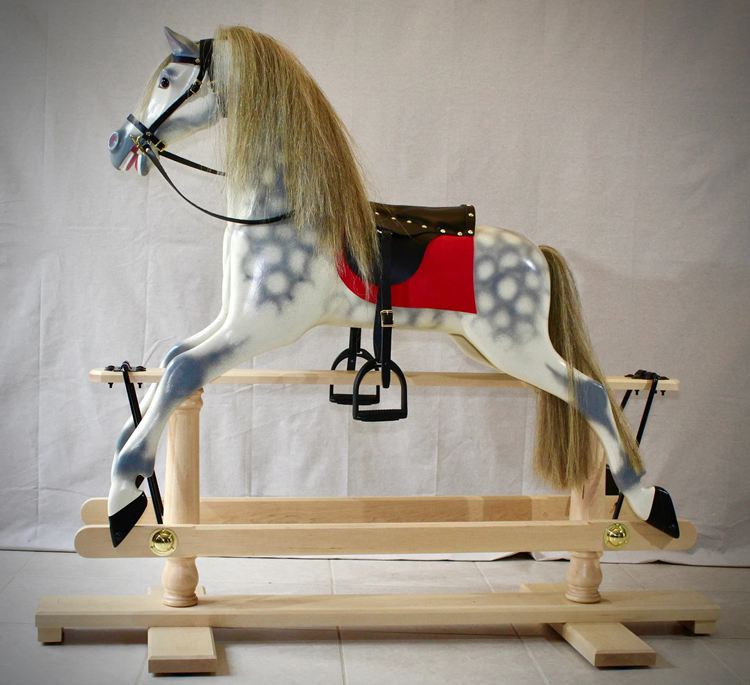
In the 1800s, Philip Marqua of Cincinnati, Ohio, designed the Marqua Stand rocker, which was trademarked in England during Queen Victoria’s reign.
In rocking horse history, the Marqua Swing Stand is sometimes referred to as the “safety stand.” This design replaces the Bow Rocker’s bow-shaped base with a glider base.
The base of the “safety stand” consists of sliding bars and swinging irons that allow the toy horse atop it to float effortlessly.
Unlike the Bow Rocker, the Marqua Stand rocker has a more stable base that allows movement without causing base movement. It is known to be safer for children because the risk of an accident is reduced.
A safety swing stand style rocking horse is priced between $1,000 to $3,200 on Etsy.
Popular Antique Rocking Horse Manufacturers to Collect
In addition to Philip Marqua, several other manufacturers have created popular and in-demand rocking horses. Although most of these rocking horses resemble bow rockers or swing stands, they are made by different companies.
We’ll look at some of the companies that make rocking horses in this section.
1. F.H. Ayres Ltd
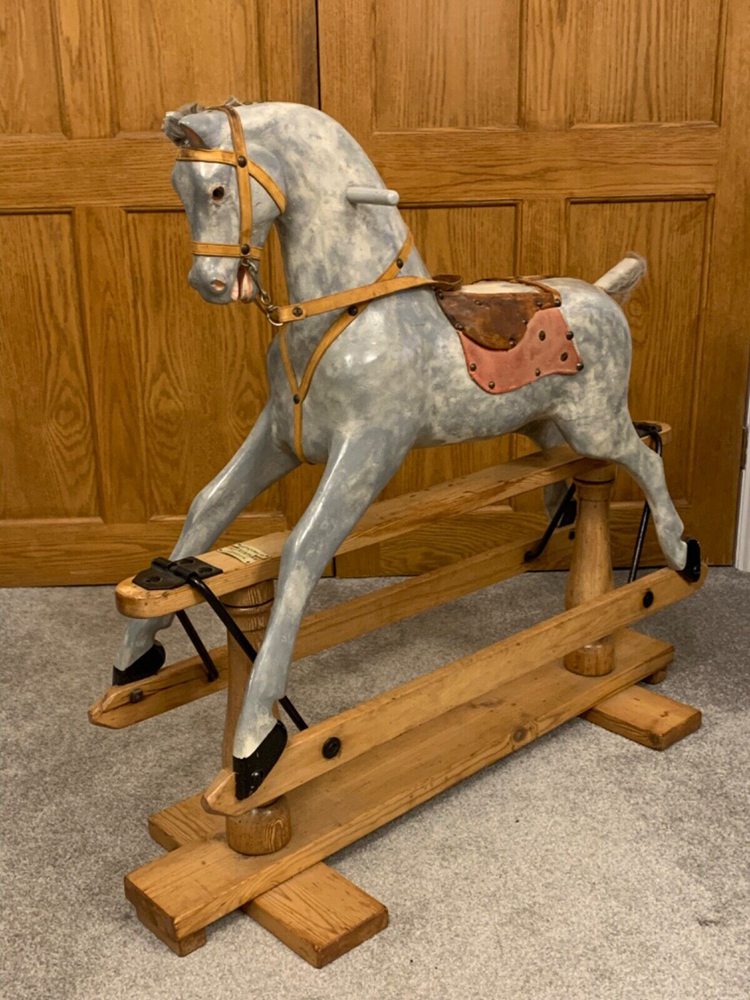
F.H. Ayres, which stands for Frederick Henry Ayres, was founded in London in the mid-nineteenth century and manufactured exquisite rocking horses until around 1940.
The ears and muzzles on the heads of F.H. Ayres rocking horses are well carved and give the horses a beautiful look. The size is typically large and well-proportioned.
The legs are exquisitely sculpted, appearing at times to be unbelievably thin in the cannon bone and pastern sections.
The majority of F.H. Ayres rocking horses are unmarked, though, the brand name is occasionally stamped under the rocking horse’s belly. On the baseboard of some is a transfer of a Maltese Cross within a Union Jack, while others feature a brass plaque.
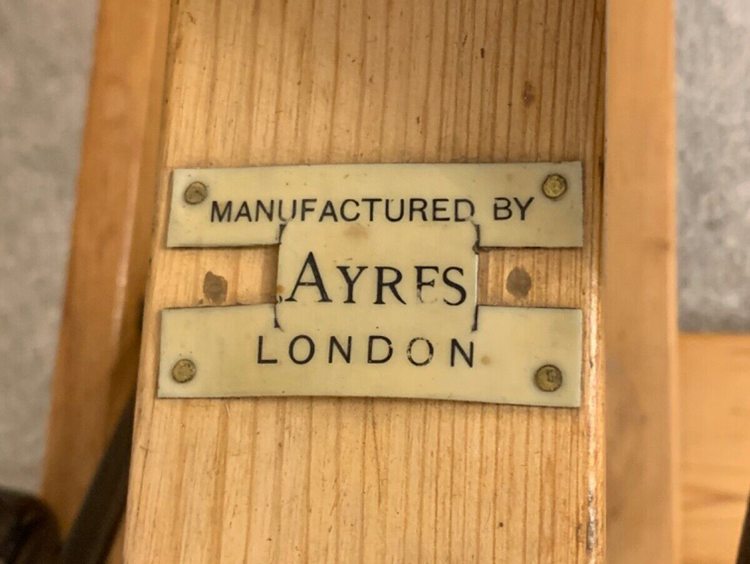
F.H. Ayres rocking horses are easily identified due to their distinct design and pattern, even when unmarked or over-painted. They are also perceived as more masculine than feminine.
Florence (the F.H. Ayres company’s only feminine-shaped rocking horse), William, Skip, Elenour, Peggoty, and Brigadier are some of the rocking horses carved by the F.H. Ayres firm.
An F.H. Ayres antique wooden rocking horse value is set at $2000+ on eBay.
Identifying F.H. Ayres Rocking Horses
Shape: It is gorgeously carved and sculpted, with exquisite heads. Commonly, the heads are turned to one side.
Eyes: Their eyes are made of glass that has been expertly painted and polished.
Tack: A vintage F.H. Ayres rocking horse has a real leather padded saddle and removable leather bridles.
Paintwork: A vintage F.H. Ayres rocking horse features painted heads and lovely mild dappling.
Stand: They are often made of pine and have magnificent traditional turned pillars. Each bracket or hinge on the rocking horse has four bolt holes.
Hair: On the head, long horse hair is used, with the most common colors being dappled light gray and brown.
2. G & J Lines Ltd.
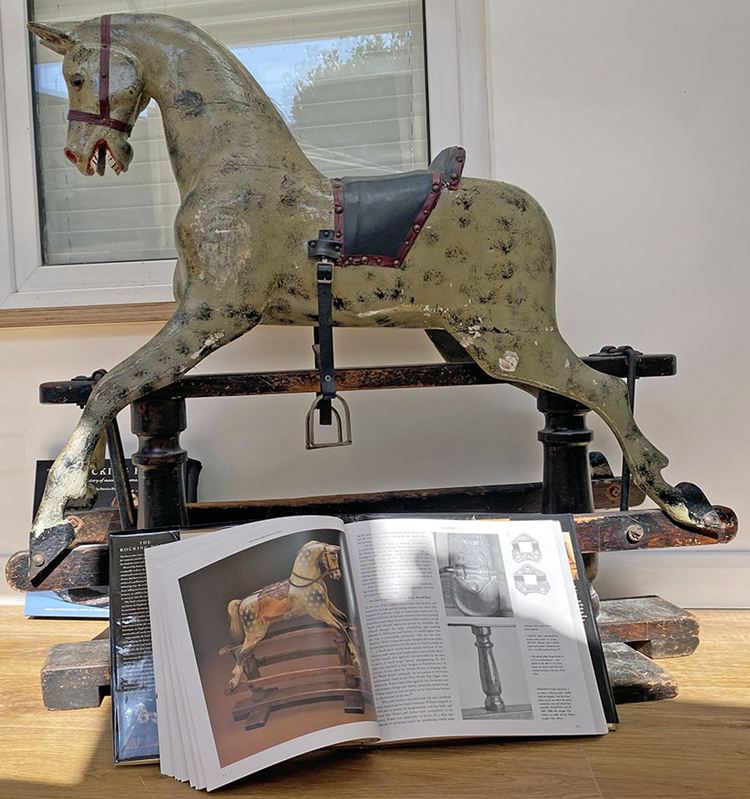
George and Joseph Lines Ltd, or G & J Lines Ltd for short, is a well-known manufacturer of traditional wooden rocking horses in Britain. The company was founded in 1876 and continued to operate until 1910.
G & J Lines is also known for producing more feminine rockers than F H Ayres, as well as bow rockers and Marqua stand-style rocking horses.
Rocking horses from G & J Lines have more enlarged nostrils and occasionally a breastplate. Additionally, they may feature rounded runners, turned pillars, and marked brackets.
Early G & J Lines rocking horses are in high demand among antique collectors seeking authentic antique rocking horses.
On websites like Etsy, an antique G & J Lines rocking horse is worth $3,000 or more.
Identifying G & J Lines Rocking Horses
Eyes: It possesses glass eyes.
Hair: Its mane and tail are covered in horse hair.
Stand: They have beautifully turned pillars with an indented collar. On the brackets or hinges, there are three bolt/screw holes. The company’s initials are sometimes inscribed at the bottom of the brackets.
Tack: They have angular pointed corners and leather-padded saddles and blankets.
Paintwork: It has a lovely, subtle body and facial painting.
3. Stevenson Brothers
Twin brothers Marc and Tony Stevenson were inspired by their uncle James Bosworthick, who had spent his entire life making toys and rocking horses. Marc and Tony hoped to start their own business making rocking horses.
Years later, after Tony tried modeling, tree milling, and working for a large American oil company, and Marc graduated from art college with a degree in graphic design, specifically in the 3D department, they both decided it was time to work together as they had imagined as kids.
So they went to their uncle James, who demanded a £1,000 training fee from one of them in order for him to learn how to build rocking horses.
It was a wise investment, and they went ahead with it. Following Tony’s training, they founded Stevenson Brothers on their sister’s farm in 1982.
Three months after setting up a small workshop on their sister’s farm, the Stevenson brothers created four horses and held a launch party for the press on October 20, 1982. This was the official launch of their business.
Today, the company’s production facility in Bethersden, England, produces the finest rocking horses in the world. A Stevenson Brothers rocking horse is worth around $4,000 or more.
Identifying Stevenson Brothers Ltd Rocking Horses
Shape: It has a distinct carving style that distinguishes it.
Tack: The saddle fabric is leather and is wrapped around the horse’s body.
Body: A key is required to open a secret chamber in the body. A plaque with the company’s name can also be found in the front of both the swing stand and the bow rockers.
4. Baby Carriages Ltd
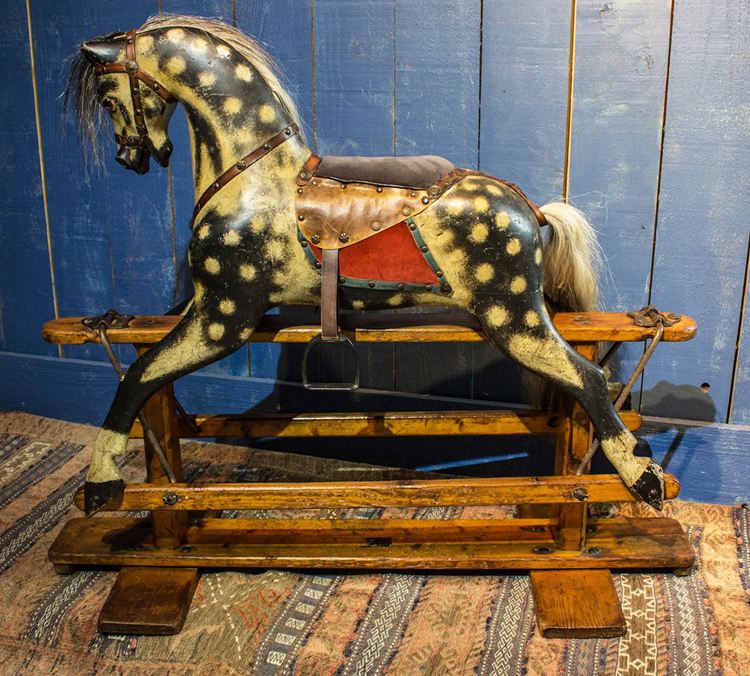
Baby Carriages Ltd, also known as Rambler, was established in 1906 by the merger of Hill & Harrison, a company that had been in operation from 1884 to 1906. The company had a factory in Liverpool and sold a variety of models under the brand name “Rambler.”
Baby Carriage rocking horses are meticulously shaped and curved. The rocking horses have a distinct profile and are occasionally confused with Collinson Brothers rocking horses.
The cost of baby carriage rocking horses on websites such as Etsy sometimes exceeds $2000.
Identifying Baby Carriages Ltd Rocking Horses
Eyes: A baby carriage rocking horse has glass eyes.
Tack: It has a saddle made of leather or, on rare occasions, velvet.
Hair: It has cow tail curly hair.
Stand: It has rectangular linear legs with rounded ends on the horizontal rails, and three holes in the hinges on top of the stand.
Paintwork: They are dappled black and gold.
5. Collinson & Sons Ltd
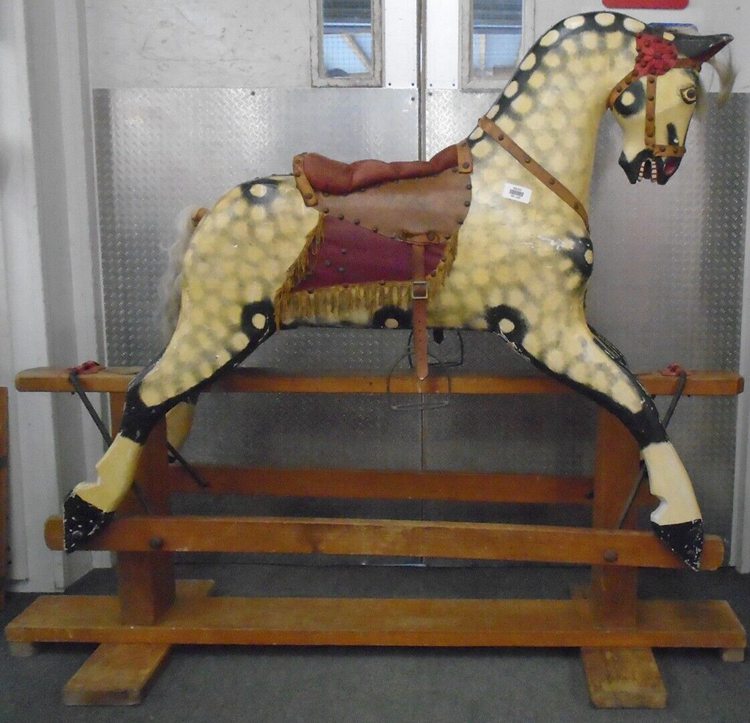
Collinsons & Sons is one of England’s oldest rocking horse makers, with rocking horses manufactured in Liverpool since 1836 and passed down through multiple generations. until the company ceased operations in the 1990s.
When Queen Victoria came to the facility in 1851, the dappled gray style was said to be her favorite. From then on, Collinsons focused on making dapple gray horses.
Collinsons’ first rocking horses were beautifully carved, with flared nostrils, wood or glass eyes, and twisted upright stand posts. The dapples on these older horses were more subtle than those on later horses, which were boldly dappled all over.
A Collinsons & Sons antique rocking horse is valued between $300 to $1,400 on eBay.
Identifying Collinson & Sons Rocking Horses
Paintwork: The paintwork is dappling dark and bold, with a lot of black. It has glaring bright red eyes, nostrils, and a mouth.
Eyes: Upholstery pins were used to make the eyes.
Tack: The saddle in the center is made of red corduroy, while the rest of the saddle is made of leatherette. A bridle has been tacked on for ornamental purposes.
Stand: It has rectangular, linear pillars with diamonds carved out on top.
6. Norton & Barker
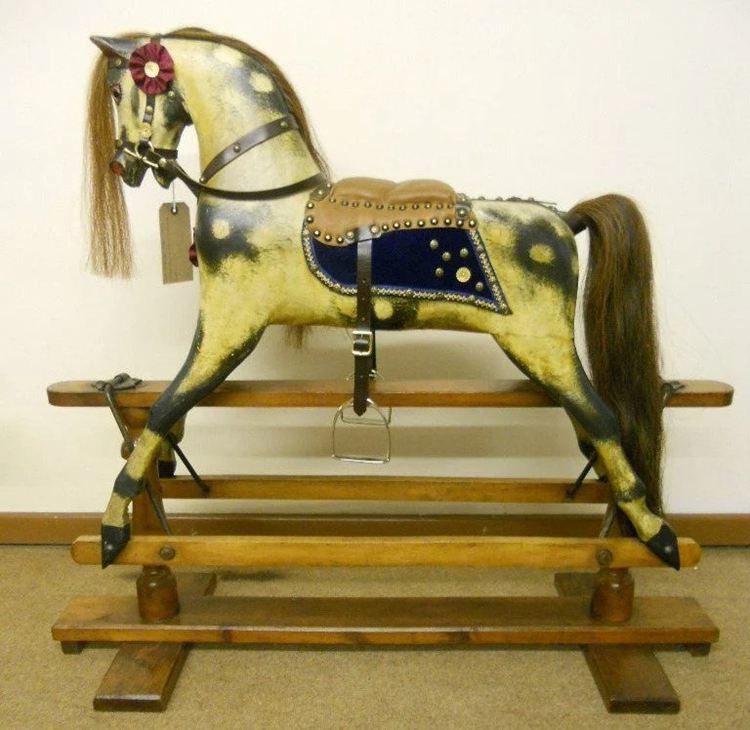
From 1890 to 1947, this Birmingham-based company produced exquisite rocking horses for children. Their toys were distinct, with features like a narrow head shape and a stand shaped like a pillar, that helped people easily tell them apart from others.
Because these toys are rarely found in their original condition, the majority of them are sold refurbished. In good condition, the price ranges from $1,450 to $1,800.
Identifying Norton & Barker Rocking Horses
Paintwork: The majority of their toys featured simple yet exquisite dappling.
Body type: These magnificent rocking horses have a vertical narrow head, a stocky body and straight legs.
Eyes: This company made rocking horses with painted eyes outlined with a red line. As a result, they may appear odd because they lack eyelashes.
Tack: Toys often had padded leather saddles but did not include a saddle block.
Stand: The pillars of the stand were thin and amorphous. Horizontal rails on toys were always neatly contoured.
7. Brassington & Cooke
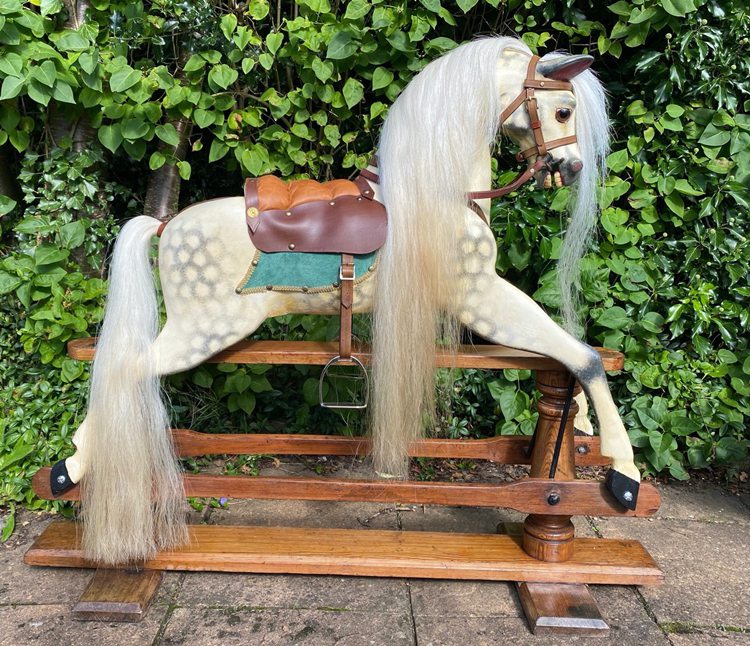
Since Brassington & Cooke only operated in 1920, their rocking horses are extremely rare. Their toys are easily distinguished from other models due to their forward-facing heads, unusually shaped legs, and bulky bodies.
Brassington & Cooke rocking horses are valued at $400 to $1000.
Identifying Brassington & Cooke Rocking Horses
Hair: The company used only natural horse hair to make the manes and tails of their toys.
Tack: They designed two types of saddles: leather and cushioned.
Head: Their head shape is narrow and faced down.
Stand: The rocking horses have a stand that is shaped like a pillar.
Other Types of Antique Rocking Horses
There are additional types of antique rocking horses based on the material used in its production and the year it was manufactured.
Spring Rocking Horses
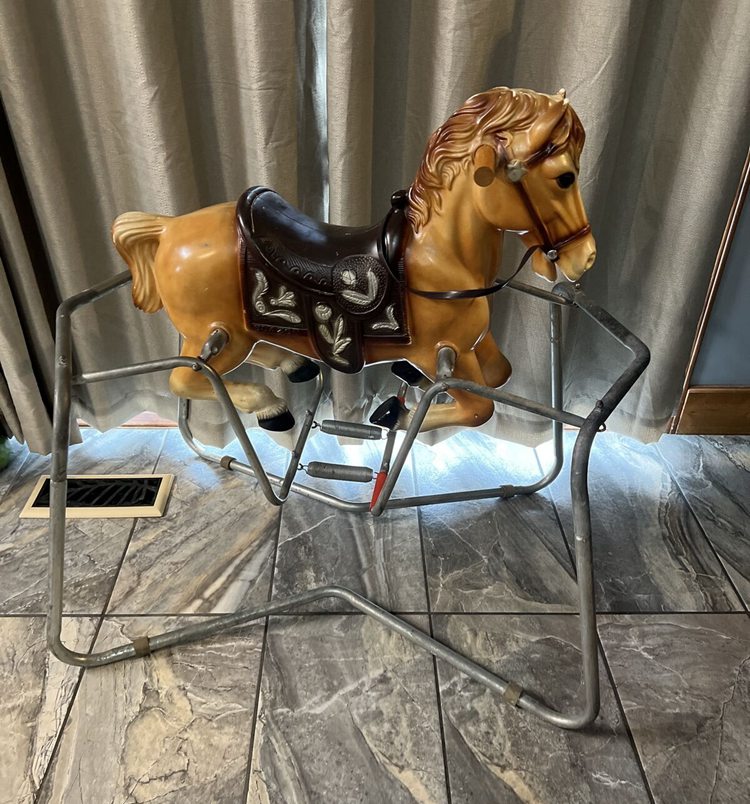
Wonder Products Co. is credited with inventing the first spring rocking horse by sculpting plastic horse bodies and suspending them from a tubular metal frame with four strong springs.
Due to the small number of collectors who purchase spring rocking horses, they are sold as reusable items rather than collectibles.
A vintage spring rocking horse’s value on auction sites such as eBay ranges between $80 and $300.
Influencing Factors on the Value of Antique Rocking Horses
The fact that the rocking horse you possess is an antique is sometimes insufficient to command top dollar for it. The following are factors that affect the value of antique rocking horses.
Size
The larger the horse, the higher the price. Collectors with limited space can use small baby bows with small swinging horses, whereas someone with a larger home may want to have a large rocking horse to make a statement in the room.
If you are considering purchasing it for children, it should be at least 37 inches tall. This should be a good size for children. Purchasing a large horse might be intimidating for younger children.
Model
Rocking horses by Brassington & Cooke, for example, are so rare that they can be sold for whatever price the seller sets and the collector is willing to pay.
The availability of other, similarly-styled models made by competing manufacturers may also affect the value of a rocking horse.
Condition
A rocking horse in good condition is more likely to sell for a higher price and faster than one in poor condition. It is possible to restore rocking horses, but the process is expensive, so prospective buyers should keep this in mind before making a purchase.
This is a very important factor that can help you determine the value of the rocking horse you want to sell or buy.
Where to Sell Valuable Antique Rocking Horse
Since antique rocking horses are highly sought after by collectors, ranging from those who simply want them for sentimental value to those who want them for decorative or functional purposes, there are various sites and shops where you can sell yours.
Etsy
Etsy is an American e-commerce website that sells handmade, vintage, and craft supplies. These products are classified into several categories, including jewelry, bags, apparel, home décor and furniture, toys, art, craft materials, and tools.
All things listed as vintage must be at least 20 years old. It is a policy that vendors must adhere to in order to avoid misrepresentation.
Etsy allows vendors to submit vintage items, and if your rocking horse is more than 20 years old, you’re good to go. To sell your things, you must first create a shop on the platform.
Gum Tree
Gumtree is a British online classified advertising and community website headquartered at Hotham House in Richmond, London.
Gum Tree ads can be posted for free or for a fee, depending on the type of item being advertised and the audience.
According to a traffic audit conducted in 2010, it had become one of the top 30 websites in the UK by November of that year, with 14.8 million monthly visitors.
If you want to sell your antique rocking horse on the site, you will need to learn how to create a shop and upload images of your horse.
Where to Buy Collectible Antique Rocking Horse
If you are a collector looking to add new rocking horses to your collection or a first-time buyer looking to try them out, this section will show you where to find antique rocking horses in good condition.
1stDibs
1stdibs is an online marketplace that sells luxury products such as high-end furniture for interior decoration, fine art, and jewelry. The company is credited with bringing the antique industry into the twenty-first century. As a result, it’s a great place to buy and sell vintage rocking horses.
All you need to do is search for your preferred rocking horse model on the site’s search bar and choose from the many options there.
eBay
eBay is a well-known e-commerce platform that facilitates sales between consumers and businesses. Buyers can bid on prices set by site vendors.
To purchase your preferred rocking horse, look for the model you want, choose a vendor based on the description or a hunch, and pay. The majority of eBay sales include free shipping. You might get lucky.
Rocking Horse Heaven
Rocking Horse Heaven is an online marketplace that sells and rents several types of rocking horses.
Users can buy, trade, or rent rocking horses on the website for a fee. The shop sells vintage
rocking horses from a variety of manufacturers, including Stevenson’s, F.H. Ayres, and Paul Leech.
To select a collectible of your choice, use the search bar to find the item you want.
Stevenson Brothers
While Stevenson Brothers continue to manufacture rocking horses, their website is also a good place to find vintage rocking horses by select manufacturers like F.H. Ayres.
Stevenson Brothers also restores and repairs both new and old rocking horses. Whether to get them back into riding shape, replace the mane and tail, or expose and refinish the original painting.
Each horse has its own personality, and Stevenson’s team works hard to ensure that your vintage rocking horse retains both its uniqueness and its antique value.
Frequently Asked Questions
1. What Wood Is A Rocking Horse Made Of?
Rocking horses are typically made from tulipwood, walnut, mahogany, oak, cherry, beech, utile, sweet chestnut, and iroko.
2. Is Riding On Wooden Rocking Horses Safe?
Wooden rocking horses are absolutely safe. Making a rocking horse out of wood is your best bet for a solid base that reduces accidents.
3. Do Kids Need Rocking Horses?
Children “invented” rocking horses after playing the game of “riding” sticks between their legs like a horse. Rocking horses help children develop good motor skills by strengthening their large muscles and upper body strength.
Conclusion
Rocking horses are among the most valuable antiques, and their rise to fame can be traced back to the simple game of “riding horses” on a hobby horse.
Rocking horses are an excellent purchase, whether it be for the sentimental value, the decoration, or for your children. Please leave a comment below if you have any additional questions regarding the value of antique rocking horses.





![Where To Sell Antique Furniture In 2022 [Ultimate Guide]](https://www.jacquelinestallone.com/wp-content/uploads/2022/09/Etsy-Your-Place-To-Buy-And-Sell-All-Things-Handmade-600x450.jpg)


